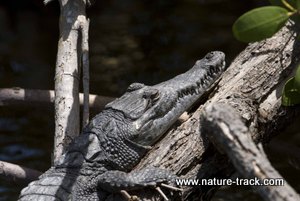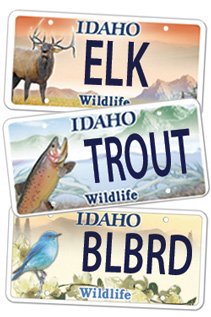The Tooth of the Matter

This American Crocodile from Florida shows off some of its impressive arsenal of teeth. With 60 teeth in its mouth, it is constantly replacing broken, worn and missing teeth to keep the weaponry at full strength.
A molar filling has gone missing, likely a victim of crunching one of those delicious partially popped pieces of popcorn my wife calls, “old maids”. I know the dental risks involved, but I just can’t seem to help myself and occasionally my teeth pay the price. Such a loss reminds me of what amazing things teeth are.
Teeth are adaptations of the vertebrate world shared by mammals, reptiles, amphibians and fish. Birds are the only vertebrate group that doesn't enjoy the blessing of true teeth, hence the saying, 'as rare as hens' teeth'.
Teeth are highly variable, ranging in size from a shrew’s pinhead-sized teeth to the ten pound single molars of an elephant to the mouthful of nine inch long spires of a Tyrannosaurus Rex.
Teeth are comprised of calcium, phosphorus, and other minerals which make up the dentine. However, they lack the collagen bones have, making teeth harder than bone and inflexible. This hardness also makes teeth important in the fossil record, as they are sometimes preserved when bone is not.
The dentine is often covered with an even harder shiny layer called enamel. The root may be open, permitting indefinite growth of the tooth, as rodents have, or it may be closed like humans.
But teeth are as individualized as each species, adapted to the lifestyle of the animal. For instance, some sharks may have half a dozen rows of serrated teeth. Poisonous snakes often have hollow fangs, and the tusks of an elephant and the pointed spire of a narwhal are modified teeth.
Fish, reptiles and amphibians have teeth that are all essentially the same, usually some form of a simple pointed shape. They are constantly replacing these teeth as well. Crocodilians, for instance, may replace 3,000 teeth in a lifetime, while sharks may replace as many as 30,000. Teeth may occur in multiple rows of rear facing fangs that make escape by prey nearly impossible.
Mammals have specific tooth patterns, called tooth formulas, based on four different kinds of teeth. The formula considers the number of incisors, canines, premolars and molars in one side of an upper or lower jaw. Humans, for instance, have 32 teeth with a tooth formula of [Incisor-2 Canine-1 Premolar-2 Molar-2] X4. Upper and lower jaw formulas are the same. Mammals also replace one set of baby or milk teeth with permanent teeth although some mammals may get multiple sets of adult teeth in a lifetime.
There are plenty of exceptions to these rules. The dolphin, for instance, only gets one set of teeth, which add a layer each year. Their teeth are also all the same: sharp conical pegs. The sheepshead, a common fish in North America, has teeth that are flat and human-looking enough to make us double check our genetic history. The musk deer has very long upper canines and the payara, a fish of the Amazon, is called the saber-tooth of the river because of two teeth up to six inches long protruding from its bottom jaw.
Thinking about brushing ten pound molars or six inch daggers makes me happy to keep my own dental issues.

Wildlife License Plates
Great news! as of 2024, there are three NEW designs for license plates. They still are bluebird, cutthroat trout and elk, but they are beautiful.
Idaho Wildlife license plates provide essential funding that benefits the great diversity of native plants and wildlife that are not hunted, fished or trapped—over 10,000 species or 98% of Idaho’s species diversity. Game species that share the same habitats (such as elk, deer, antelope, sage-grouse, salmon, trout) also benefit from these specialty plates.
No state tax dollars are provided for wildlife diversity, conservation education and recreation programs. Neither are any revenues from the sale of hunting or fishing licenses spent on nongame species. Instead, these species depend on direct donations, federal grants, fundraising initiatives—and the Idaho Wildlife license plates.
Both my vehicles have Bluebird Plates. I prefer the bluebird because the nongame program gets 70 percent of the money from bluebird plates, but only 60 percent of the money from elk and trout plates - 10 percent of the money from elk plates supports wildlife disease monitoring and testing programs (to benefit the livestock industry) and 10 percent from cutthroat plates supports non-motorized boat access.
Incidentally, in 2014, the Idaho Legislature denied the Department of Fish and Game the ability to add new plates or even to change the name of the elk and cutthroat plates (very specific) to wildlife and fish plates, a move that would have allowed for changing images occasionally and generating more revenue. It would seem that they believe that we Idahoans don't want a well funded wildlife program.
I think it is time we let the Legislature know that Idahoan support wildlife funding and that we would like to see these generic plates come to fruition.
Wildlife License Plates
Great news! as of 2024, there are three NEW designs for license plates. They still are bluebird, cutthroat trout and elk, but they are beautiful.
Idaho Wildlife license plates provide essential funding that benefits the great diversity of native plants and wildlife that are not hunted, fished or trapped—over 10,000 species or 98% of Idaho’s species diversity. Game species that share the same habitats (such as elk, deer, antelope, sage-grouse, salmon, trout) also benefit from these specialty plates.
No state tax dollars are provided for wildlife diversity, conservation education and recreation programs. Neither are any revenues from the sale of hunting or fishing licenses spent on nongame species. Instead, these species depend on direct donations, federal grants, fundraising initiatives—and the Idaho Wildlife license plates.
Both my vehicles have Bluebird Plates. I prefer the bluebird because the nongame program gets 70 percent of the money from bluebird plates, but only 60 percent of the money from elk and trout plates - 10 percent of the money from elk plates supports wildlife disease monitoring and testing programs (to benefit the livestock industry) and 10 percent from cutthroat plates supports non-motorized boat access.
Incidentally, in 2014, the Idaho Legislature denied the Department of Fish and Game the ability to add new plates or even to change the name of the elk and cutthroat plates (very specific) to wildlife and fish plates, a move that would have allowed for changing images occasionally and generating more revenue. It would seem that they believe that we Idahoans don't want a well funded wildlife program.
I think it is time we let the Legislature know that Idahoan support wildlife funding and that we would like to see these generic plates come to fruition.

"WOW. What a phenomenal piece you wrote. You are amazing." Jennifer Jackson
That is embarrassing, but actually a fairly typical response to my nature essays. Since The Best of Nature is created from the very best of 16 years of these nature essays published weekly in the Idaho Falls Post Register (online readership 70,000), it is a fine read. It covers a wide variety of topics including humorous glimpses of nature, philosophy, natural history, and conservation. Readers praise the style, breadth of subject matter and my ability to communicate complex and emotional topics in a relaxed and understandable manner.
Everyone can find something to love in this book. From teenagers to octogenarians, from the coffee shop to the school room, these nature essays are widely read and enjoyed.
Some of the essays here are my personal favorites, others seemed to strike a chord with readers. Most have an important message or lesson that will resonate with you. They are written with a goal to simultaneously entertain and educate about the wonderful workings of nature. Some will make you laugh out loud and others will bring a tear to the eye and warm your heart.
Readers Write:
"You hit a home run with your article on, Big Questions in Nature. It should be required reading for everyone who has lost touch with nature...great job!" Joe Chapman
"We enjoyed your column, Bloom Where Planted. Some of the best writing yet. The Post Register is fortunate to have your weekly columns." Lou Griffin.
To read more and to order a copy, click here or get the Kindle version
Copies are also available at:
Post Register
Island Park Builders Supply (upstairs)
Barnes and Noble in Idaho Falls
Harriman State Park, Island Park
Museum of Idaho
Valley Books, Jackson Wyoming
Avocet Corner Bookstore, Bear River National Wildlife Refuge, Brigham City, Utah
Craters of the Moon National Monument Bookstore, Arco, Idaho